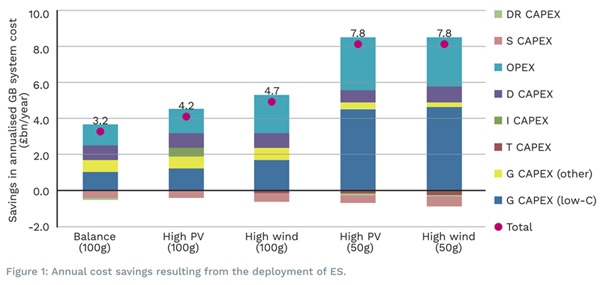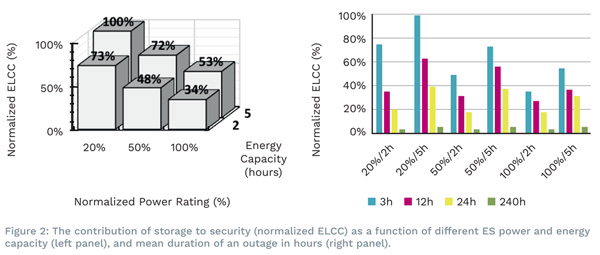The transition towards low-carbon electricity systems raises severe challenges with respect to increased balancing requirements and degradation in asset utilisation. Energy storage (ES) constitutes a flexible option that can offer numerous services and facilitate a cost-effective decarbonisation of our electricity systems. In the following sections we highlight and quantify the value of some key functions that ES could perform in the future.
WHOLE-SYSTEM BENEFITS OF ENERGY STORAGE
The WeSIM model, developed at Imperial College, was applied to quantify the benefit of installing 20GW of ES to the electricity system of Great Britain in future scenarios that feature a high penetration of variable renewables in the year 2030. Figure 1 shows the mix of cost and benefits across five scenarios; the first three and latter two achieving a carbon intensity target of 100 and 50g/KWh respectively. Sensitivity studies were also undertaken around the amount of photovoltaic and wind generation that could be installed at the time (denoted high PV and high wind). The annual net benefit of storage was found to be between 3.2 and 7.8 billion £/year.

The model computed costs and benefits across several components:
- Investing in ES (S CAPEX) is the capital cost of deploying 20GW of ES across the country.
- Investment in cross-border interconnection capacity (I CAPEX).
- Investment in demand-side response capability (DR CAPEX).
- System operating cost (OPEX) through energy arbitrage, balancing and frequency regulation.
- Distribution investment (D CAPEX) by supporting power management in distribution networks.
- Transmission investment (T CAPEX) by managing north to south power transfers.
- Generation investment (G CAPEX) since ES reduces the need to invest in peaking capacity units (other) and low-carbon units (low-C).
In the scenario with carbon target of 50gCO2/kWh, most of the benefits of ES are related to reducing the investment in low-carbon generation, while meeting the carbon reduction objective, through enhancing the ability of the system to integrate variable renewable generation. In this case, ES enables the system to meet the carbon emission target by building 10GW less nuclear generation or 17GW less wind generation.
SECURITY CONTRIBUTION OF ENERGY STORAGE
ES can also play a role in enhancing the security of electrical systems; they can provide peak shaving capability and maintain supply during network faults. Nevertheless, current design standards do not recognise that ES can be an attractive alternative to conventional network reinforcements and little work has been done to quantify the firm capacity that ES can provide. Note that ES is fundamentally different to other assets in two respects (i) ES faces energy constraints due to its limited capacity (ii) ES ability to charge is tied to the reliability of the network. In this context, extensive analysis undertaken by Imperial College has demonstrated that the Equivalent Load Carrying Capability (ELCC) of ES can be significant, but it largely depends on a number of factors such as ES power/energy capability, network reliability, demand shape and others.

In Figure 2 (left panel) we show the security contribution of ES as a function of power (expressed as a percentage of peak demand) and energy capacity (expressed in terms of hours); we show that energy capacity plays a key role since it is key in sustaining operation during fault conditions. In the right panel we show ELCC of six different ES plant sizes across four network reliability scenarios; the less reliable the network, the less the ES contribution. This analysis is the first step towards incorporating ES in existing design standards and enabling it to compete with other technologies.
OPTION VALUE OF STORAGE
ES’s recognized ability to defer investment can have additional strategic value when facing long-term uncertainty. Nowadays planners often have to green-light projects ahead of need due to anticipation of rapid demand and/or generation growth and lengthy permitting and asset delivery procedures. ES entails lower stranding risks because even if the envisaged scenario that warranted its deployment does not materialize, it can still contribute to operation by providing other support services. Furthermore, fast-deployable solutions such as ES can 'buy time' until uncertainty is resolved:
CONCLUSIONS
It is clear that ES can offer a multitude of services which are bound to become increasingly important in the future decarbonization effort. ES can assist with system balancing, frequency regulation, defer investment in network and generation assets leading to cost-effective achievement of carbon reduction targets, provide network security as well as provide option value by aiding in the management of long-term uncertainty. Nevertheless, many of these benefits are not recognised by the current regulatory regimes and design standards worldwide. Levelling the playing field and allowing ES to compete with other technologies is imperative to ensure efficient levels of ES are deployed and that our future energy systems are flexible and future-proof.
Contact information
Goran Strbac
Imperial College
Email: g.strbac@imperial.ac.uk